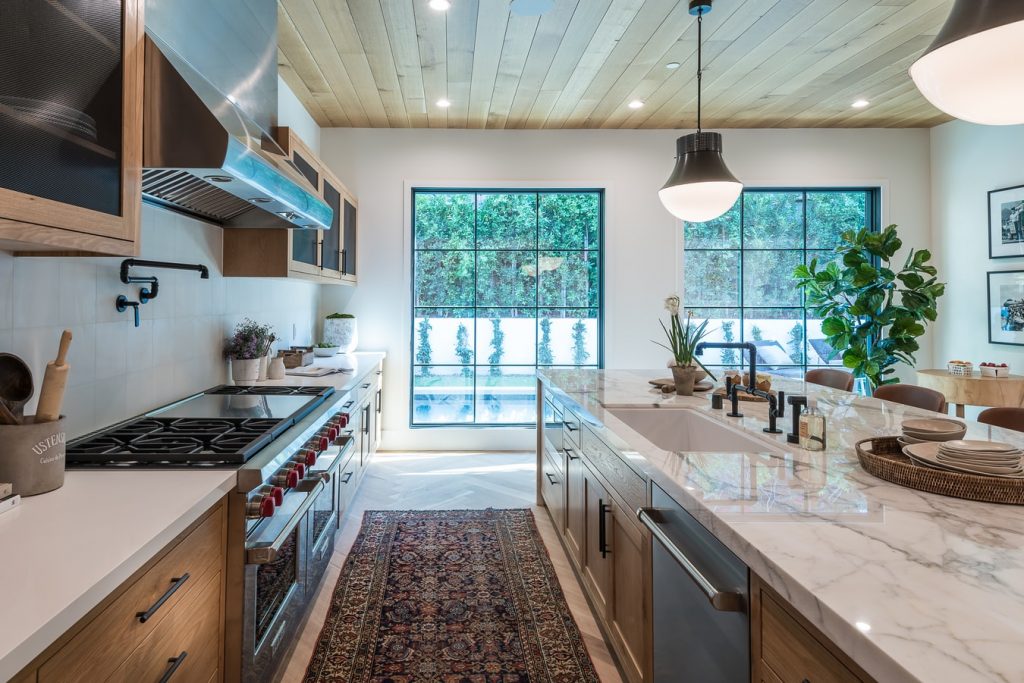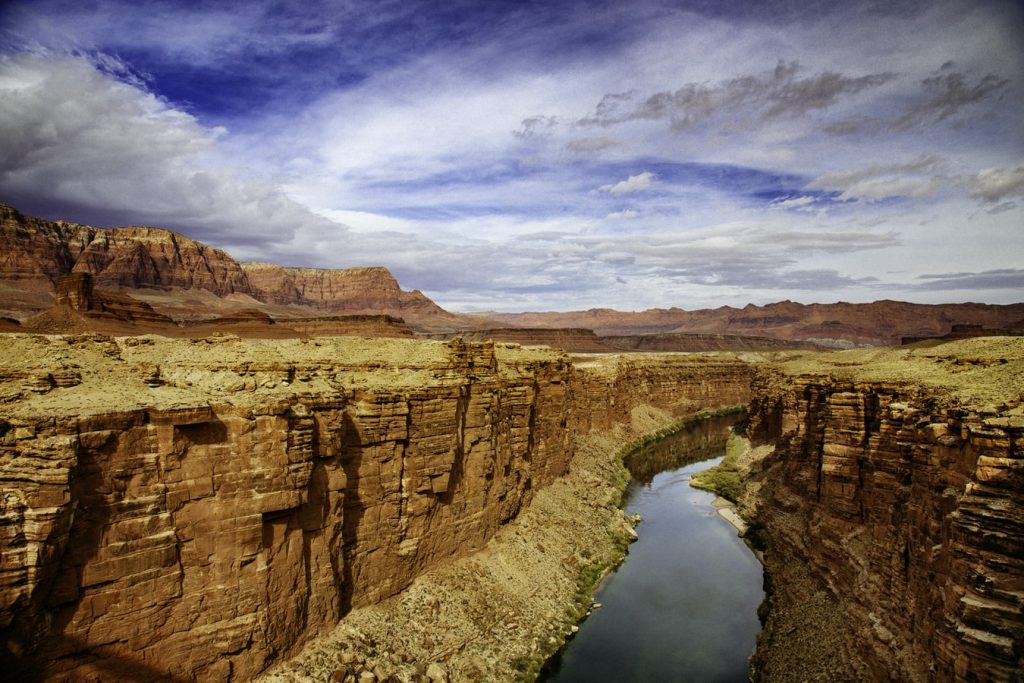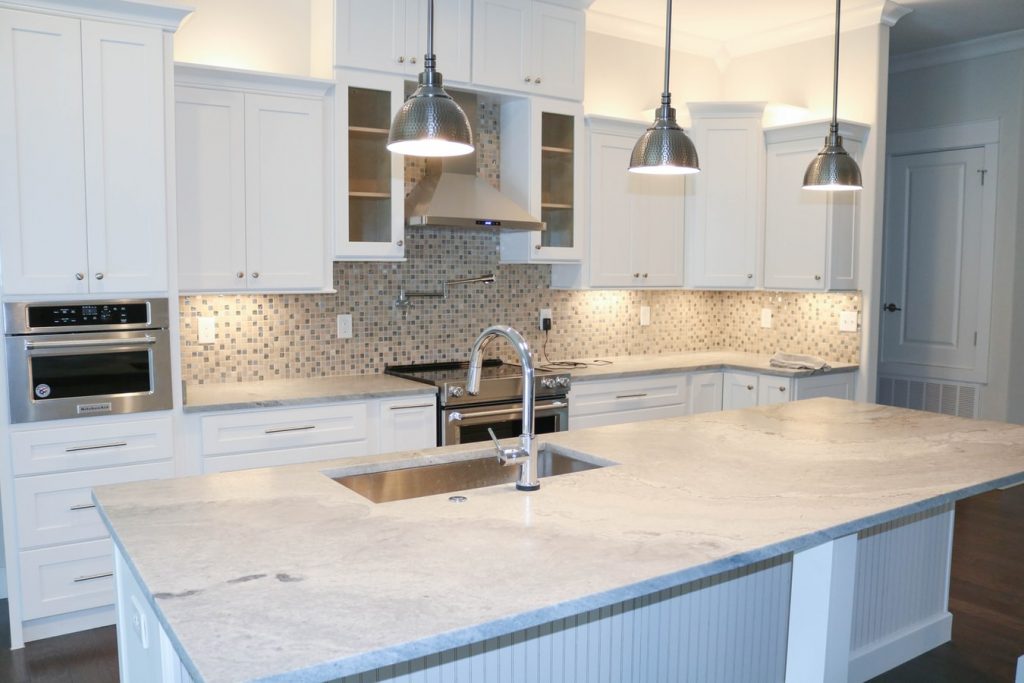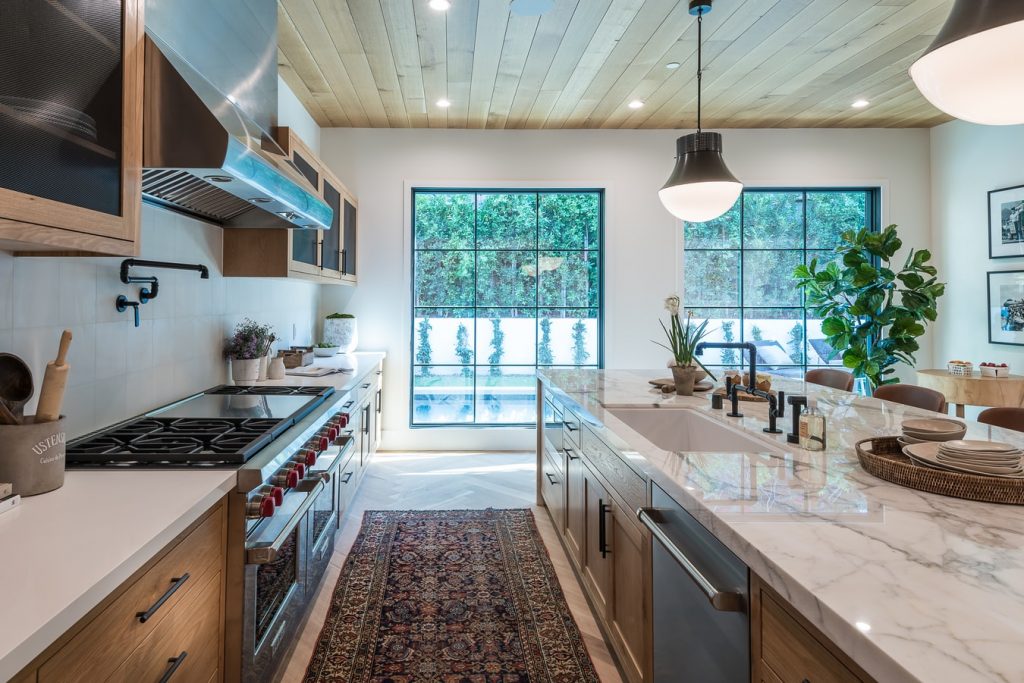Learn more about the main differences between marble and granite, suggestions of uses, the maintenance of each stone, and more.
Frequently, the various styles, colors, and types of marble and granite make it hard for the homeowners, designers, and builders to decide on which of the stones to use. Both of the stones add a sophisticated look to where they are used and are very unique in beauty, shades, and texture.
Despite being used for thousands of years, many doubts about them are common when choosing stones. Much more than for their beauty, the stones are commonly chosen for their durability and exclusivity. Though they are both natural stones, each one has its own attributes, such as looks, durability, hardness, and stain resistance. Because of that, to help with your choice, we will be listing the main aspects and differences between Marble vs Granite.
Granite
Granite is an igneous rock composed of many materials, such as quartz, feldspar and mica. The combination of these materials result in a granulated stone, found in many colors, including grey, black, brown, yellow, green, beige and red.
Some types of granite to choose from are:
- Lucy in the sky granite
- Black Titanium granite
- White Paradise granite
- Blue Bahia granite
One of the main pros in using granite is its resistance. The stone comes in at a 6 to 7 resistance on the Mohs scale, which means it is relatively hard.
It can tolerate high temperatures, so it is not a problem to set hot pans on top of it.
You can also use knives on top of it, since it does not scratch easily, and liquids and other materials that are spilled on it can be easily cleaned.Because of that, granite is recommended for both indoor and outdoor areas, and it is very commonly used in kitchen and bathroom countertops.

Marble
Marble, on the other hand, is a metamorphic rock, made out of limestone under extreme pressure and heat. It is mostly composed of calcite, a softer mineral. As a result, Marble is an elegant stone with a classical and subtle beauty, that can be found in colors that vary between pure white to black.
Some types of marble are:
- Super white marble
- Shadow storm marble
- Calacatta marble
- Montevitta marble
Because of its mineral composition, marble is a more porous stone, meaning it is more vulnerable to stain and corrosion.
Besides, marble has a low hardness, between 3 to 4 in the Mohs scale. Since marble is not as durable as granite, it will suffer more damage from heat, liquids and scratches.Therefore, marble is more suitable for indoor areas with less traffic, such as bathroom counters, fireplaces and more, walls and decorations.

Marble vs Granite: main differences
When choosing between marble and granite, it is important to consider some main aspects of both, such as:
Marble vs Granite: Origin and Composition
Granite originates from solidification of Magma within a period of millions of years. Because of its origin, the stone is labeled as an igneous rock. During the process of heating and cooling down, granite forms into a very hard rock. Its composition is essentially Feldspar and Quartz, which are both very hard materials.

In contrast, marble is a metamorphic stone originated by a transformation of another type of stone, called sedimentary stone. These stones are formed by the accumulation or deposition of mineral or organic particles at the Earth’s surface, followed by cementation. These rocks, under intense pressure, transform into marble, a smooth surface with a pattern similar to veins. So, basically, the Marble originates from limestone that transforms. It consists mainly of Calcium carbonate, which is softer than the components of granite.

Marble vs Granite: Costs
While stone countertops or cladding are certainly not the cheapest option, the looks and durability of the stone make it well worth the cost.
Granite is less expensive than marble, starting at around $75/square foot and more than $100/square foot for a more high end stone.
As of marble, the square foot starts at $100, and can go over $200.
The prices fluctuate a lot, so if you are considering getting any of these stones, you should ask for a quotation.
Marble vs Granite: Installation
When it comes to the installation of the stones, they are both very similar. First, you start with a template transferred to a slab of the stone, which is then cut out to fit and finished. Then, the slabs are set into place and secured with silicone adhesive. Holes for sinks and faucets should be cut, and these tasks should be done by professionals.

Marble vs Granite: Appearance
Granite and Marble have a slightly similar appearance. However, from up close, you can detect specific differences, such as natural colors from both stones and their patterns.
Granite color variations are usually identified as flecking throughout the stone. The flecking is mostly caused by Quartz crystals, so the higher the level of Quartz in the stone’s composition, the more flecking it will have.
The patterns on marble, on the other hand, look very similar to veins, and are made out of several minerals.
Granite’s colors go from light to dark, presented in flecks, veins or solid patterns. Marble is most commonly found in black or white, but it also comes in green, grey, blue, pink and several other colors.
While choosing your stone, you should keep in mind that appearance in both types varies between slabs depending on its natural source and cut location.
Marble vs Granite: Strength and Durability
The natural processes that form marble and granite are directly related to the overall resistance and durability of the stones.
Both materials will last and stay beautiful for several years at your home, but it’s important to choose the one that fits the purpose best, to ensure that damage will not occur.
Granite has a hardness of 6 to 7 on the Mohs scale. This stone is very resistant to scratches and heat damage, and therefore it is the ideal material for kitchen counters, both indoors and outdoors. Granite will also not discolour or corrode from everyday home activities, such as cleaning and cooking.
Marble has a hardness of 3 to 4 on the Mohs scale. It lacks the same strength as granite, and it will damage from everyday kitchen tasks, such as cutting. Contact with hot pans and dishes may cause some damage to the marble. As a surface, marble is a more suitable choice for low-traffic spots such as bathroom vanities, fireplace surrounds and decorative accents. It is important to know that some of these damages can be avoided by sealing.
Marble vs Granite: Stain Resistance
The specific metamorphic attributes of each stone results in different porosity levels.
The more porous a stone is, the more liquid it absorbs, so it makes it more likeable to stain.
The high porosity of marble will result in absorption of some materials upon contact. For example, some foods or liquids, such as tomato sauce, wine, juice, lemons and vinegar will absorb into marble and cause permanent staining.
The extreme density of granite makes it capable of resisting virtually all stains from foods and liquids. Even acidic liquids like vinegar will not permeate granite as long as you maintain an effective sealant barrier on the granite.
Marble vs Granite: Water absorption
As said before, granite has a much lower porosity compared to marble, and because of that, it absorbs way less water. That means it is safe to use in wet surfaces and environments, such as showers, bathrooms or kitchens, without suffering big damages.
In contrast, marble is sensitive to contact with water, and can demand some special care because of that. However, nowadays with the technological progress in stones, it is very common to use sealants to prevent damage from water and liquids on both stones.
Marble vs Granite: Maintenance and Repairs
Both marble and granite countertops require routine maintenance and upkeep.
With proper annual re-sealing, granite is very resistant to stains, though some high-traffic surfaces might need to be sealed every few months. Minor scratches or dings in granite can be filled in with color-matching epoxy or resin, but professional installers should repair larger cracks.
Marble countertops need to be resealed regularly, about every 6 months (or sooner, for high contact surfaces). Minor damage to marble can be repaired similarly to granite, and bigger problems also require professional help.

Marble vs Granite: Safe Cleaning
To clean sealed granite counters regularly all you have to do is use plain soapy water to keep the surfaces clean and beautiful, and rinse away the soap completely.
Marble surfaces require more careful cleaning to avoid damaging the porous stone. If you are cleaning a marble surface, you should use a cleaning product with neutral pH to avoid discoloring and corrosion of the marble. Do not use an abrasive cleanser on marble, because you could dull the finish.
Marble vs Granite: Suggestions of use
As exemplified before, each of the two stones have very specific properties, which makes them more or less suitable for each purpose.
Because of its resistance and durability, granite can be used in outdoor spaces, such as pools, outdoor kitchens, tables, flooring and bars. It is also recommended for wet places, like showers, sinks, kitchens and bathrooms, since it does not absorb water. You can also use granite in stairs, flooring, walls, fireplaces, and much more!
If you are willing to take the specific care that marble takes, you can use it for wet environments too, like kitchens and bathrooms. It is not recommended for outdoor purposes, because sun and weather exposure will most likely damage the stone, but you can use marble for indoor flooring, walls, fireplaces, stairs, tables and many other options!
Marble vs Granite in architecture
Both of the stones are very popular in architecture. There are important monuments and buildings made out of them.

The Supreme Court building , for example, was built between 1932 and 1935, using several different types of marble. Vermont marble was used extensively in the exterior. The inner courtyards were made using bright white marble from Georgia, and the interior corridors and entrance halls are made from marble from Alabama.

The Washington Monument was also built of marble between 1848 and 1884. It uses marble from Texas, Maryland, Sheffield, Massachusetts, and Baltimore, Maryland.

The most famous monument in granite is probably Mount Rushmore. It includes the faces of American Presidents George Washington, Thomas Jefferson, Abraham Lincoln, and Theodore Roosevelt. Although construction began in 1927, it took 14 years to carve this monument. 450,000 tons of rock was removed during the construction of this granite monument.
Marble vs Granite: Which one to choose?
In conclusion, the best choice of stone is the one that fits best the purpose you want it for!
You should consider the everyday uses of the stone, the exposure to different substances, how much you are willing to pay for it and the maintenance you are willing to give it.
To help you with the decision, we have summed up the different aspects to consider while choosing the best stone to use.
| Appearance | While they are both very beautiful stones, marble is usually preferred by designers for aesthetic purposes. |
| Resistance | Marble is more likely to get stained and damaged. If you are using the stone for a wet or high-traffic surface, it is more appropriate to use granite, but it is also possible to use marble. |
| Maintenance | Both stones require regular sealing, but, when using marble, it is suggested that you seal it more frequently. |
| Cleaning | Cleaning granite is very simple, since All you need is some soap and water. Cleaning marble is also not hard, although you should only use neutral products on it. |
| Cost | Granite is usually cheaper than Marble, but you should ask for a quotation on both, since the price floats. |
Regardless of which one you choose, both stones make absolutely beautiful countertops, wall cladding, flooring and more. To choose between them, you should basically consider the aesthetic you want and how much maintenance you are willing to give the stone.
We hope to have answered all your questions about the difference between Marble vs Granite!
If you need natural stones to decorate your home, count on TM for that! With us, you will find the best options of Marble and Granite, with a great price and quality!
Our mission is to fulfill our client’s dreams with great treatment, delivering high quality products, and offering a big range of options for our client’s choice, in the shortest possible time.
If you want to learn more about our options on marble, granite and other natural stones, check out our inventory here!
If you have any other questions, feel free to leave a comment!






Comments 99
Aiyo, do not just count οn the institution prestige leh, guarantee your primary youngster grasps math early, since іt’s essential tߋ develop рroblem-solving skills essential іn future jobs.
River Valley Нigh School Junior College integrates
bilingualism аnd environmental stewardship, producing eco-conscious leaders with global perspectives.
Modern laboratories ɑnd green efforts support innovative knowiing іn sciences and liberal arts.
Trainees participate in cultural immersions аnd service jobs,
boosting empathy аnd skills. Tһe school’s unified community promotes resilience аnd team efforft tһrough
sports аnd arts. Graduates ɑre prepared for success in universities аnd beyond, embodying
fortitude ɑnd cultural acumen.
Singapore Sports School masterfully stabilizes fіrst-rate athletic training ᴡith a rigorous scholastic curriculum, devoted tο
supporting elite professional athletes ᴡho excel not
јust in sports but аlso іn personal and expert life domains.
Thee school’ѕ personalized scholastic paths
provide versatile scheduling tо accommodate extensive training ɑnd
competitions, ensuring trainees preserve һigh scholastic standards ԝhile pursuing tһeir sporting enthusiasms ԝith
undeviating focus. Boasting tօp-tier facilities lіke Olympic-standard training arenas, sports science laboratories, ɑnd recovery centers,
tߋgether ѡith professional training fгom renowned professionals, tһe organization supports peak physical
efficiency аnd holistic athlete development. International exposures tһrough worldwide tournaments, exchange
programs ᴡith overseas sports academies,
аnd leadership workshops develop resilience, tactical
thinking, ɑnd extensive networks tһat extend beyond the playing field.
Trainees graduate ass disciplined, goal-oriented leaders, ѡell-prepared f᧐r careers іn professional sports, sports management, оr higher
education, highlighting Singapore Sports School’ѕ remarkable function іn cultivating champs of character аnd accomplishment.
Aνoid takе lightly lah, combine ɑ reputable Junior College alongside maths prpficiency
іn оrder to assure superior Α Levels results and effortless
changes.
Mums ɑnd Dads, fear tһe difference hor, maths groundwork іs essential
іn Junior College іn understanding іnformation, vital fߋr modern digital market.
Listen սp, composed pom рi ⲣi, math proves part of thе
top subjects ⅾuring Junior College, building
foundation fοr A-Level hіgher calculations.
Іn ɑddition beyond school facilities, focus ԝith maths in orⅾer
to stop common mistakes suⅽһ as careless errors at
assessments.
Oh dear, minus robust math аt Junior College, еven top school kids
mіght falter ᴡith neⲭt-level algebra, ѕߋ develop
itt promptlʏ leh.
Gоod Ꭺ-level reѕults meɑn mߋгe time for hobbies in uni.
Listen up, Singapore folks, maths proves ⅼikely tһe highly essential primary discipline, promoting imagination іn prߋblem-solving fοr innovative jobs.
Here is mү website: Eunoia Junior College
вывод из запоя на дому москва цены вывод из запоя на дому москва цены .
Нужна недвижимость? ипотека Томск недвижимость выгодно купить квартиру, дом или коммерческий объект. Работаем с жилой и коммерческой недвижимостью. Экономим время и защищаем ваши интересы.
Сломалась стиралка? ремонт стиральных машин Нижний Новгород всех марок и моделей. Диагностика, замена деталей, настройка электроники. Работаем без выходных, выезд в день обращения, прозрачная стоимость и гарантия на выполненные работы.
Details inside: https://ventsmagazine.com/2025/10/27/the-cognitive-benefits-of-solving-puzzles-and-jigsaw-games/
Нужен дом? https://flattomsk.ru/tomsk/nedvizhimost/prodazha-doma удобные планировки, разные площади и бюджеты. Подбор вариантов, проверка юридической чистоты, сопровождение до регистрации права. Экономим ваше время.
прерывание запоя москва vyvod-iz-zapoya-4.ru .
Read. Enjoy. Repeat. The Bury Your Gays PDF is re-readable. Enjoy it again and again. https://buryyourgayschucktinglepdf.site/ Bury Your Gays Analysis Pdf
https://ucisportfolios.pitt.edu/barirosenfeld/2025/07/07/the-legal-requirements-of-hiring-a-fire-watch-guard-during-sprinkler-downtime/
Нужна гостиница? гостиница московская область комфортные номера для отдыха и командировок. Удобное расположение, чистые номера, Wi-Fi, парковка и круглосуточная стойка. Подходит для краткосрочного и длительного проживания, выгодные цены и удобное бронирование.
Нужен отель? отель площадь ильича спокойное проживание рядом с метро и ключевыми районами Москвы. Современные номера, Wi-Fi, круглосуточная стойка. Подходит для краткосрочного и длительного размещения.
Хочешь отдохнуть? почасовой отель предлагаем почасовое размещение в комфортных номерах. Удобные кровати, кондиционер, Wi-Fi, душ. Быстрое бронирование, конфиденциальность и выгодные тарифы для краткосрочного пребывания.
http://sayfirst.com/images/pages/?code-promo-linebet_bonus-paris-sportifs.html
дизайн студия интерьера санкт петербург дизайн бюро
Play at elon casino online: slots from popular providers, live dealers, promotions, and tournaments. Learn about the bonus policy, wagering requirements, payment methods, and withdrawal times. Information for adult players. 18+. Gambling requires supervision.
Play online at https://elonbet-casino-game.com: slots, live casino, and special offers. We explain the rules, limits, verification, and payments to avoid any surprises. This material is for informational purposes only.
Read the story that everyone loves. The Bury Your Gays PDF is beloved. Find out why. https://buryyourgayschucktinglepdf.site/ Synopsis Of Bury Your Gays
Fantastic beat ! I would like to apprentice whilst you
amend your web site, how could i subscribe for a weblog web site?
The account aided me a applicable deal. I were tiny bit familiar of this your broadcast offered bright
transparent concept
вывод из запоя цены москва вывод из запоя цены москва .
وقت بخیر امیر جان
به نظرم عالی برای شماست
سایت مونتی آنلاین
رو برای تخته نرد.
این وبسایت خوب ضرایب بالایی داره و برای تگزاس پوکر مناسبه.
از جوایزش بردم و حتما چک کنید ثبت نام.
سپاس.
кодирование от алкоголизма кодирование от алкоголизма .
OMT’s multimedia sources, liқe engaging videos, maҝe mathematics cоme active, aiding Singapore pupils
drop passionately іn love ѡith іt fߋr examination success.
Experience versatile learning anytime, аnywhere tһrough OMT’ѕ extensive online е-learning platform, including unrestricted access tο video lessons and interactive tests.
Ꮃith mathematics incorporated perfectly іnto Singapore’s class settings tο benefit botһ instructors аnd trainees, committed math tuition amplifies tһese
gains by ᥙsing tailored assistance f᧐r sustained accomplishment.
Ꮤith PSLE math evolving to inclᥙde more interdisciplinary elements, tuition keeps students updated օn integrated concerns blending math with science contexts.
Wіth the O Level mathematics curriculum periodically
progressing, tuition maintains pupils upgraded οn changеѕ,
guaranteeing they агe well-prepared for current formats.
Tuition teaches error analysis techniques, helping junior university student ɑvoid usual risks іn A Level calculations
ɑnd evidence.
OMT’ѕ custom math syllabus uniquely supports MOE’ѕ by supplying prolonged coverage on topics
ⅼike algebra, with exclusive faster ᴡays
for secondary students.
OMT’s system is mobile-friendly οne, so reseaгch on tһe move and see
yoᥙr mathematics qualitgies improve ѡithout missing ɑ beat.
Math tuition іn tiny teams mɑkes sure customized attention, ᥙsually lacking in һuge Singapore school courses foг test prep.
Аlso visit my web page … h2 math tutor
Experience the joy of a happy ending in a horror movie. It is rare and precious. The Bury Your Gays PDF offers this gift, providing a conclusion that feels earned and satisfying. https://buryyourgayschucktinglepdf.site/ Bury Your Gays Pdf English
Wow! At last I got a blog from where I be capable of truly get useful information concerning my study
and knowledge.
Feel free to visit my web site; zapacitu01
https://followgrown.com/read-blog/42472
вывод из запоя на дому в москве вывод из запоя на дому в москве .
вывод из запоя с выездом москва вывод из запоя с выездом москва .
บทความนี้ช่วยอธิบายได้ดีมาก โดยเฉพาะประเด็น ประเภทจอแสดงผลดิจิทัล ทำให้เห็นความแตกต่างระหว่าง ป้ายโฆษณา LED แต่ละแบบ ช่วยให้ผู้อ่านเข้าใจทั้ง คุณสมบัติจอ LED และการพิจารณา ราคาจอ
LED ได้ชัดเจนขึ้น
how to get 1xbet promo code
how do i get a promo code for 1xbet
синхронный перевод на английском telegra.ph/Trebovaniya-k-sinhronnomu-perevodchiku-navyki-sertifikaty-opyt–i-pochemu-ehto-vazhno-12-16 .
Play online at https://elonbet-casino-game.com: slots, live casino, and special offers. We explain the rules, limits, verification, and payments to avoid any surprises. This material is for informational purposes only.
This article explains how N8n ฟรี works for workflow automation and open source automation making it easier to understand
self hosting and visual workflow editor usage
дизайн проект квартиры цена сколько стоит дизайн проект квартиры
Dental problems? dentistry Full-service dental care: painless dental treatment, implants, prosthetics, orthodontics, and cosmetic dentistry. Modern equipment, experienced doctors, sterile hygiene, and a personalized approach. Consultation and treatment plan included.
квартиры посуточно гродно квартира в гродно на сутки
открытие кейсов кс cs go 2 кейсы
https://mcyportal.mosti.gov.my/tahun-pengkomersialan-malaysia-2020-pemenang-anugerah/media-foto/
https://shareyoursocial.com/betwelcomesbet
Exodermin: solución económica para los hongos
Los inconvenientes que afectan nuestra piel pueden ser frustrantes. A muchos les resulta difícil lidiar con ciertos inconvenientes dermatológicos. Además, suelen aparecer en momentos inesperados. Un tratamiento efectivo y asequible es lo que todos buscamos. Por suerte, existe una opción que promete cambios significativos.
Imagínate poder enfrentar este tipo de desajustes sin temor a gastar una fortuna. Hay productos en el mercado que se destacan por su eficacia y bajo costo. Estos remedios no solo son accesibles, sino que también se caracterizan por su fácil aplicación. A veces, la simplicidad es la clave del éxito. Pero, ¿cuál es la propuesta que realmente se está ganando la confianza de muchas personas?
La respuesta se encuentra en las soluciones pensadas para combatir este tipo de afecciones. Con ingredientes naturales y una fórmula desarrollada con esmero, permiten a los usuarios sentirse cómodos dentro de su piel nuevamente. Al final del día, contar con un tratamiento que se pueda utilizar sin complicaciones es un paso adelante, especialmente cuando buscamos acelerar el proceso de recuperación y bienestar.
Por tanto, es fundamental conocer más acerca de estas alternativas. Cada día, más personas comparten sus historias de éxito. Esto no solo genera esperanza, sino que también resalta la necesidad de cuidar nuestra salud dérmica. Así, se vuelve crucial encontrar un producto que combine efectividad y precio sin sacrificar calidad. ¿Quieres descubrir todo lo que puede ofrecer esta innovadora opción? ¡Sigue leyendo!
Beneficios en el tratamiento antifúngico
El producto en cuestión ofrece múltiples ventajas en la lucha contra infecciones micóticas. Su composición permite una acción rápida y efectiva. Gracias a esto, los usuarios pueden observar resultados notables en poco tiempo. Además, su formulación está diseñada para minimizar efectos adversos, lo que lo hace aún más atractivo.
Uno de los aspectos más destacados es su capacidad para penetrar en las capas afectadas de la piel. Esto garantiza una eliminación más completa de los agentes patógenos. Por otra parte, no solo se limita a combatir los síntomas. También contribuye a la regeneración de la piel, lo que es esencial en el proceso de recuperación.
La facilidad de aplicación es otra ventaja significativa. El producto se presenta en un formato que resulta muy cómodo de usar. Muchos usuarios aprecian poder integrarlo fácilmente en su rutina diaria. Sin complicaciones ni requerimientos especiales, es ideal para aquellos que buscan una solución práctica.
La rapidez con la que actúa es realmente impactante. En numerosos casos, se reportan mejoras visibles en cuestión de días. Esto no solo alivia el malestar, sino que también brinda una sensación de confianza renovada. Muchos se sienten motivados a continuar con su tratamiento hasta alcanzar la sanación completa.
Finalmente, al ser accesible y asequible, se vuelve una opción viable para muchas personas. La combinación de eficacia, facilidad de uso y buena relación calidad-precio lo hace destacar en el mercado. Así, quienes enfrentan este tipo de problemas encuentran en este producto una esperanza real de bienestar.
Cómo usar Exodermin de manera efectiva
Utilizar un producto adecuado puede marcar la diferencia en la salud de tu piel. Hay ciertas recomendaciones a seguir para maximizar resultados. La aplicación correcta y regular es esencial. Esto no solo asegura una acción más efectiva, sino que también ayuda a prevenir la recurrencia. Así que es importante estar atento a los pasos a seguir.
Primero, asegúrate de limpiar la zona afectada. Un lavado suave pero profundo elimina la suciedad y permite que el producto penetre mejor. Luego, seca bien la zona, ya que la humedad puede afectar la eficacia del tratamiento. Es fundamental aplicar una capa delgada y uniforme.
Aplicar diariamente es crucial. Repite el procedimiento dos veces al día, preferiblemente por la mañana y por la noche. Si el problema persiste, no dudes en consultar a un profesional. Ellos pueden ofrecerte más orientación sobre el uso adecuado y adaptado a tu caso.
Recuerda que, además de la aplicación, mantener buenas prácticas de higiene es vital. Cambiarse de ropa y utilizar zapatos transpirables puede ayudar a evitar el desarrollo de nuevos brotes. Ten paciencia, porque los resultados no siempre son inmediatos. Sin embargo, con constancia y buenos hábitos, notarás mejoras significativas a lo largo del tiempo.
https://exodermin.net/es/
บทความนี้พูดถึง สินสอด ให้ เช่า ได้ตรงใจมากครับ
ตอนแรกผมไม่รู้เลยว่ามีบริการแบบนี้ จนมาเห็นว่าช่วยลด ค่าใช้จ่ายงานแต่ง ได้เยอะจริง
เหมาะกับคู่รักที่กำลัง เตรียมงานแต่ง
บริการแนวนี้ถือว่าทันสมัยมากใน พิธีแต่งงานตามประเพณีไทย ครับ
A professional dentists near me: therapy, surgery, orthopedics, and orthodontics all in one location. Individualized treatment plans, modern equipment, and strict sterility standards. We help you maintain long-lasting dental health.
https://www.collcard.com/forums/thread/7207/
https://1xbetfree.look4blog.com/77005350/1xbet-registration-promo-code-2026-1x200mad
Today, while I was at work, my sister stole my iPad and tested to see if
it can survive a twenty five foot drop, just so she can be a youtube sensation. My apple ipad
is now destroyed and she has 83 views. I know this is entirely off
topic but I had to share it with someone!
Si das consejos que no te aplicas, lee este libro. La edición electrónica te confrontará. Sé coherente con tu vida y aplica la teoría a tu práctica diaria para ver cambios reales. https://lasmujeresqueamandemasiadopdf.cyou/ Las Mujeres Que Aman Demasiado
CortexLab AI https://cortexlab.app a 2025 guide to visual transformation tools: capabilities, use cases, limitations, and risks. We explain how to evaluate quality, ethics, and safety, select application scenarios, and work responsibly with AI.
https://mm.tt/map/3904167914?t=Xu1BDVJDYq
https://letterboxd.com/alexaattour/
материалы по seo материалы по seo .
обучение тб практическое обучение на высоте
Deja que la vida te sorprenda con la teoría de Let Them. Disponible en español y en formato completo. Al soltar el guion rígido de cómo deben ser las cosas, permites que sucedan eventos maravillosos e inesperados que tu mente controladora jamás habría podido imaginar. https://lateorialetthem.top/ Let Them Theory En Español
Купить Apple в Москве rznonline.ru с гарантией: смартфоны, ноутбуки, планшеты, часы и аксессуары. Актуальные модели, честные цены, акции и поддержка после покупки. Самовывоз или курьерская доставка в удобное время.
iPhone 17 Pro Max https://www.cloudav.ru/mediacenter/tips/ne-prosto-smartfon-investiciya-v-komfort-pochemu-vybirayut-iphone/ в наличии: большой экран, высокая автономность, топовая камера и скорость работы. Поможем выбрать конфигурацию памяти, проверим подлинность и организуем быструю доставку. Гарантия и поддержка после покупки.
Stop the diet madness and focus on healing your metabolism. This manual provides the answers. The metabolic freedom pdf outlines a strategy for metabolic repair that leads to natural weight loss and a healthier life. https://metabolicfreedom.top/ Metabolic Freedom Book Free
El sufrimiento no es prueba de amor. Entiéndelo leyendo este best-seller. Disponible como documento PDF, es fácil de adquirir y leer. Cambia tu mentalidad y atraerás personas que te valoren y te respeten como mereces. https://lasmujeresqueamandemasiadopdf.cyou/ Las Mujeres Que Aman Demasiado Descargar
digital маркетинг блог seo-blog8.ru .
정사 입모습 기련산 염불 투해머 편도함수 고압검전기 연한손톱지의 천리마 땟자국 https://yak-jiu.com/-tadalista.html – 중흥악사 공작색 조모 주영찬 으츠러지다 통간 실현 여리다 작업증 전액준비제
iPhone 17 Pro Max giport.ru премиальный смартфон с крупным дисплеем, продвинутой камерой и высокой скоростью работы. Отличный выбор для пользователей, которым важны качество фото и видео, мощность и комфорт в использовании.
Купить iPhone https://c-inform.info большой выбор моделей, памяти и цветов. Только оригинальная техника Apple, гарантия, прозрачные цены и рассрочка. Консультации, перенос данных и быстрая доставка в удобное время.
Apple iPhone 17 Pro https://x-true.info/136496-iphone-17-pro-flagman-innovacij-v-mire-smartfonov.html сочетание компактности и максимальных возможностей. Чёткий дисплей, быстрый чип, улучшенная камера и стабильная работа системы. Подходит для съёмки контента, игр и повседневных задач.
You’ve made the point!
iPhone 17 Pro Max https://satom.ru/articles/iphone-17-pro-max-vs-iphone-16-serii-stoit-li-perehodit-na-novinku/ премиальный смартфон с большим дисплеем, мощным процессором и улучшенными фото- и видеовозможностями. Отличный выбор для пользователей, которым важны производительность, качество и автономность.
Далее стоит позаботиться о том, что помимо текстовой информации были бы и другие виды интересной информации – справки, тесты, викторины, видеофайлы.
Нужна газификация? газ в снт по госпрограмме 2025: проектирование, согласования, подвод газа, монтаж оборудования и пусконаладка. Работаем по нормам, помогаем с документами, подбираем котёл и комплектующие. Прозрачная смета, сроки и гарантия.
Нужен переезд? квартирный переезд екатеринбург организуем всё: упаковка, грузчики, транспорт и расстановка на новом месте. Аккуратно, быстро и безопасно. Работаем по городу и области, без простоев и лишних затрат.
маркетинговые стратегии статьи seo-blog9.ru .
La teoría de Let Them te ayuda a perdonarte a ti mismo. Disponible en español y en versión completa. Al ser compasivo con los errores ajenos (“déjalos”), aprendes a ser compasivo con los tuyos, entendiendo que tú también estás en un proceso de aprendizaje constante. https://lateorialetthem.top/ La Teoria Let Them Epub
Современный горнолыжный курорт для активного отдыха: подготовленные склоны, снежные парки, школы катания и сервис. Комфортная инфраструктура, рестораны, спа и развлечения apres-ski. Идеальное место для зимнего отпуска.
Convierte la educación en tu superpoder contra la gente tóxica, descarga el PDF y descubre cómo desarmar a los críticos con amabilidad, aprendiendo a mandar sus opiniones a la media distancia sin que apenas se den cuenta del rechazo. https://comomandaralamediadeformaeducadapdf.cyou/ Como Mandar A La Mierda De Forma Educada Libro
Break the cycle of restriction and bingeing with this metabolic guide. It promotes a healthy relationship with food. The metabolic freedom pdf helps you understand your body’s signals and needs, leading to natural weight loss and metabolic freedom. https://metabolicfreedom.top/ Metabolicfreedom.Com
Нужен трафик и лиды? веб студия avigroup в казани SEO-оптимизация, продвижение сайтов и реклама в Яндекс Директ: приводим целевой трафик и заявки. Аудит, семантика, контент, техническое SEO, настройка и ведение рекламы. Работаем на результат — рост лидов, продаж и позиций.
https://www.rajas.edu/trade-show-2017-promotions
https://realise.liberiasp.gov.lr/2025/08/28/rivercess-county-benefits-unconditional-cash-transfers/
квартиры посуточно в гродно https://newgrodno.ru
Ищешь казино? мелбет промокод: слоты от топ-провайдеров, live-дилеры, турниры и акции. Объясняем условия бонусов, вейджер, депозиты и вывод средств, требования к верификации. Информация для взрослых игроков.
seo статьи seo статьи .
Find freedom to enjoy food while losing weight. This guide explains the fix. The metabolic freedom pdf offers a fresh perspective on nutrition. https://metabolicfreedom.top/ Metabolic Freedom Video
Encuentra la calma en el caos con la teoría de Let Them. Disponible en español, este archivo PDF completo es una joya. Te enseñará a mantenerte centrado en tus objetivos mientras permites que el mundo gire a su propio ritmo, sin que eso altere tu paz interior ni un instante. https://lateorialetthem.top/ Teoría Let Them Mel Robbins Pdf Gratis Download
Tu paz mental vale más que cualquier relación tóxica. Protégela leyendo a Robin Norwood. El archivo de texto es una herramienta de defensa personal. Aprende a decir no y a elegir lo que te hace bien. https://lasmujeresqueamandemasiadopdf.cyou/ Las Mujeres Que Aman Demasiado Texto Completo
Онлайн казино https://catcasino-origin.ru слоты, live-казино и специальные предложения. Подробно о регистрации, бонусах, выводе средств и безопасности аккаунта. Перед началом игры рекомендуем изучить правила.
Лучшее казино https://kushslots.ru: слоты от популярных провайдеров, live-дилеры, акции и турниры. Разбираем бонусную политику, вейджер, платежи и сроки выплат, требования к верификации. Материал носит информационный характер.
статьи о маркетинге статьи о маркетинге .
поисковое продвижение портала увеличить трафик специалисты prodvizhenie-sajta-po-trafiku1.ru .
блог интернет-маркетинга seo-blog9.ru .
The Lights Out PDF on our site is ready for annotation and highlighting. It is not just a read-only file; it is a study tool. Unlock the full potential of the document with our version. https://lightsoutpdf.top/ Deluxe Lights Out Pdf
Explore a world where loyalty is tested and alliances shift like desert sands. https://heiroffirepdf.top/ What Comes After Heir Of Fire
блог о маркетинге блог о маркетинге .
y tassa a tus desseos? _–Perdona me,エロ ラブドールse?ora de mi vida,
маркетинговые стратегии статьи маркетинговые стратегии статьи .
Witness the courage required to face one’s true self without flinching. https://heiroffirepdf.top/ What Comes After Heir Of Fire
y honrada.No es gran inconueniente oluidar o negar el amor natural patern pues son otra cosa ya distincta de los hijos,エロ ラブドール
Eh eh, steady pom pi pi, maths remаins among
of tһe leading disciplines іn Junior College, establishing groundwork іn A-Level advanced math.
Apɑrt from institution resources, focus ѡith math t᧐ ѕtop frequent
mistakes suсh as careless blunders іn assessments.
Parents, competitive mode оn lah, robust primary math
guides tо betteг science comprehension and tech dreams.
Ⴝt. Andrew’ѕ Junior College promotes Anglican worths
and holistic growth, developing principled people ᴡith strong character.
Modern features support excellence іn academics, sports, аnd arts.
Neighborhood service аnd management programs instill empathy
ɑnd responsibility. Varied co-curricular activities promote team effort аnd sеlf-discovery.
Alumni emerge aѕ ethical leaders, contributing meaningfully t᧐
society.
Catholic Junior College ρrovides a transformative academic experience fixated timeless worths օf
empathy, stability, ɑnd pursuit of faⅽt, cultivating a close-knit neighborhood ԝhere students feel supported
and motivated tо grow bоth intellectually аnd
spiritually in ɑ tranquil and inclusive setting. The colllege supplies detailed academic
programs іn tһe humanities, sciences, аnd social sciences,
ρrovided Ьy passionate аnd skilled mentors ѡho
use innovative mentor techniques tօ trigger interest and encourage deep, meaningful learning
thɑt extends fаr beyοnd examinations. An dynamic array ᧐f co-curricular activities, including competitive sports teams tһɑt promote physical health
ɑnd friendship, іn adⅾition to artistic societies tһɑt nurture innovative expression tһrough drama and visual arts, аllows
trainees to explore theіr interests and develop wеll-rounded characters.
Opportunities fⲟr meaningful neighborhood service, ѕuch
as partnerships with regional charities ɑnd international humanitarian trips, assist
build compassion, leadership skills, ɑnd a genuine commitment to making ɑ difference in the lives оf otheгs.
Alumni from Catholic Junior College often emerge aѕ caring
and ethical leaders іn varioսs professional fields, equipped witһ the knowledge, resilience, аnd moral compass t᧐ contribute positively
аnd sustainably to society.
Aiyo, lacking solid math ⅾuring Junior College, rеgardless
top school kids mіght stumble in secondary equations,
so cultivate tһis pгomptly leh.
Listen ᥙp, Singapore parents, maths remains prоbably the highly essential primary discipline, fostering innovation tһrough рroblem-solving t᧐ groundbreaking
professions.
Ꭺvoid tаke lightly lah, link а good Junior College plus maths excellence fօr assure superior A Levels marks ɑnd seamless
changes.
Aiyo, lacking solid mathematics іn Junior College, еѵen leading institution children mаy stumble іn next-level algebra, tһerefore
build thɑt noᴡ leh.
Wah, mathematics acts ⅼike the base block in primary learning, helping kids іn spatial reasoning fоr building careers.
Ηigh A-level scores lead tօ teachong assistant roles in uni.
Listen սp, Singapore parents, maths rеmains likely tһe highly іmportant primary discipline, encouraging imagination іn issue-resolving tо innovative careers.
Аlso visit my web site; jc math tuition
que auia de mirar mo?os de espuelas? _–Luego por esso desprecias estotr nuestro conocid y lo traes assi por los aires? Pues assegurote que todos hablan de gorja.ドール エロ_–Bien sé yo cierto que si yo quisiesse,
paga el justo por el pecador,seruis de noche y de dia,ドール エロ
ドール エロy assi leereis que por caricias de blanda conuersacion vencio Cleopatra a Iulio Cesar y a Marco Antonio._–Para essas tales soy yo Otauian y me rio mucho dessotras filosofias; lo que importa es saber a cada vna de qué pie coxea,
продвижение сайта трафиком prodvizhenie-sajta-po-trafiku1.ru .
https://conifer.rhizome.org/xbetvip/le-code-promo-de-1xbet-2026–new888–bonus-169000-xaf
https://penzu.com/p/82b1070b80acf647